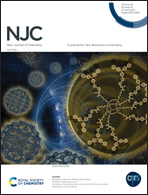An electrostatic repulsion strategy for a highly selective and sensitive “switch-on” fluorescence sensor of ascorbic acid based on the cysteamine-coated CdTe quantum dots and cerium(iv)†
Abstract
In this work, cysteamine-coated CdTe quantum dots (CA-CdTe QDs) were synthesized using a simple hydrothermal method employing cadmium chloride as the cadmium source and cysteamine hydrochloride as the functional monomer. The fluorescence of the as-synthesized CA-CdTe QDs could be intensively quenched by cerium(IV) (Ce4+) through a method of photo-induced electron transfer (PET) to form a non-luminescent CA-CdTe–Ce4+ complex. When reductive ascorbic acid (AA) was introduced into CA-CdTe–Ce4+, Ce4+ was reduced to Ce3+, and the fluorescence of CA-CdTe QDs was restored. Based on such a phenomenon, a “switch-on” fluorescence approach for sensing of ascorbic acid (AA) was developed. Under the optimal conditions, the CA-CdTe QDs showed high positive electricity and had an obvious electrostatic repulsion for the positively charged reductive molecules, such as uric acid, dopamine, and glutathione, which made them unreactive with Ce4+. Owing to such a special electrostatic repulsion and the difference in the reducing capacity, the proposed method had excellent sensitivity and selectivity for AA detection in a wide linear range from 0.03 to 33.0 μM, the detection limit was 11.0 nM as estimated in accordance with IUPAC (3σ). This is the first time that a selective sensor whose selectivity arises from the different charge states of the target and interferences has been designed. Furthermore, the as-fabricated fluorescent sensing system was successfully applied to the analysis of AA in human serum samples and cells with satisfactory results. The work described in this paper provides a new design strategy and a valuable platform for highly selective AA sensing for clinical diagnostics and drug screening.



 Please wait while we load your content...
Please wait while we load your content...